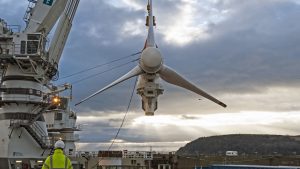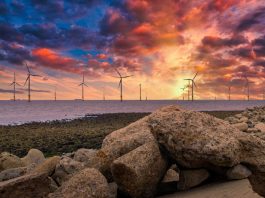Rémi Gruet, CEO of Ocean Energy Europe, explores the opportunities, challenges, and future of Europe’s ocean energy sector.
Europe stands at the forefront of a promising new renewable energy frontier—ocean energy. With the potential to generate 100 gigawatts of capacity and create hundreds of thousands of jobs, wave and tidal energy are emerging as vital components of Europe’s clean energy future. Unlike wind and solar, ocean energy provides consistent and predictable power, making it a valuable asset in the transition to a stable, carbon-free electricity grid.
However, despite its promise, the sector faces challenges, from securing investment to navigating complex permitting processes. While European funding has provided crucial early-stage support, scaling up ocean energy to full commercial deployment will require stronger commitments from both policymakers and private investors. Meanwhile, competition from the US and China is intensifying, putting pressure on Europe to act swiftly if it wants to maintain its leadership in this sector.
To explore the opportunities, challenges, and future prospects of ocean energy in Europe, we speak with Rémi Gruet, CEO of Ocean Energy Europe. With years of experience advocating for the sector, Gruet offers valuable insights into what it will take to industrialise ocean energy, attract investment, and ensure Europe remains at the cutting edge of this transformative industry.

What are the most significant opportunities and challenges facing Europe’s Ocean Energy sector today?
The most significant opportunity lies in the creation and industrialisation of a new economic sector based on ocean energy, primarily wave and tidal energy. This is a sector that is being developed in Europe, with 100% European content in the devices currently being deployed. Scaling up this sector could lead to 100 gigawatts of capacity and create approximately 400,000 jobs in the EU economy, including opportunities for export.
This industry could provide 10% of the EU’s electricity through a renewable source that complements wind and solar, as it generates power at different times. This makes ocean energy a valuable addition to Europe’s energy grid, offering significant economic opportunities for Member States.
In terms of challenges, securing the necessary financing remains the biggest hurdle. As an innovative sector, we require financial support to reach commercialisation. There is currently strong funding at the European level, but continued support is needed, particularly at the Member State level, to attract private investors. Ultimately, public funds alone cannot sustain this sector—it needs private investment to scale successfully.
You mentioned that ocean energy complements other renewable sources like wind and solar. How does it compare in terms of cost, efficiency, and scalability?
Currently, ocean energy is more affordable at its level of deployment than wind and solar were at comparable stages. This is because we’ve been able to integrate lessons learned from offshore wind, allowing us to enter the pre-industrialisation phase at a lower cost. Today, ocean energy technologies have cost levels similar to floating wind projects.
Like offshore wind, ocean energy technology relies on materials such as steel, cement, epoxy resin for blades, and electrical equipment. The primary difference is that medium—wind turbines use air, while tidal and wave devices operate in water. Tidal energy, in particular, closely resembles wind technology. While wave energy differs slightly, it shares similar scalability.
To generate the same power output as a coal plant, we would need a large number of ocean energy devices. However, this is beneficial for cost reduction because mass production allows for standardisation, automation, and economies of scale—making cost reductions easier compared to fossil fuel plants or nuclear power.
Ocean Energy Europe recently announced 15 projects over the next five years. How do you think this will drive industrialisation in the sector?
These projects mark the beginning of true industrialisation. We’ve never seen such a high level of development before. To clarify, these are publicly funded projects, meaning they have received financial backing and a seal of approval. Many have already attracted private investment, increasing their likelihood of success.
With 165 megawatts of capacity and approximately 140 machines, this initiative is the start of scaling up production. It will enable the standardisation of components like turbine blades for tidal and help manufacturers refine production techniques.

Once deployed, these projects will generate valuable electricity and data, helping to guide future developments. This transition from research and development to industrialisation and commercialisation is critical for the sector’s success.
What barriers must be overcome to move from pilot projects to full-scale commercialisation?
Funding remains the primary barrier. Innovative technologies are inherently more expensive in their early stages. Developing and deploying prototypes can cost between €5m to €20m per unit, requiring significant investment. The electricity sector is not one where new products can be introduced daily—each project requires careful financial planning.
Public funding has played a crucial role in supporting wind and solar industries in their early years, and the same is needed for ocean energy. Member States can assist by offering revenue support systems that bridge the gap between early-stage costs and market competitiveness. Once initial deployments prove successful, costs will decline, reducing reliance on subsidies.
Similar to wind and solar energy today, there are barriers related to permitting and consenting, particularly in many European Member States, where these processes take an excessively long time. These delays must be addressed, as investors are unlikely to commit to projects with a 10-year return on investment.
Investors are looking for a return within three years. If the permitting process—excluding environmental permits, but rather the procedural approvals required in member states—takes five years, it becomes unappealing. In that time, investors could have reallocated their funds twice elsewhere. Streamlining these approval timelines is crucial to accelerating project implementation and fostering the sector’s growth.
What role should government policies and funding play in accelerating the development of the sector?
Governments must take the lead by implementing policies that accelerate permitting and consenting, as well as by funding the first commercial projects—10, 50, and eventually 200 megawatts. Once the sector reaches a certain scale, subsidies will naturally decline or become unnecessary.
This responsibility falls on individual Member States, as the European Commission does not dictate national energy policies. Countries with ocean energy resources or strong industrial capabilities—like Sweden and Finland—have a strategic advantage in leading the sector’s industrialisation.
A great example is offshore wind: Denmark and Germany have dominated this market and now control 99% of it through Siemens and Vestas, two European companies. With the right government support, ocean energy can achieve similar success.
How crucial is private sector investment for the industry’s growth?
Private investment is vital—it’s the other half of the equation. Public funding helps make projects bankable, which in turn attracts private investors.
For example, in the UK, a revenue support system for tidal energy has been in place for several years. As soon as this scheme was introduced, projects began moving forward, and investors showed interest. A clear business case and financial viability encourage private investment.

This is a new sector, which makes it appealing to investors looking to gain early expertise and future financial rewards. However, the risks are higher due to the technology’s innovative nature. Public funding plays a critical role in mitigating these risks and ensuring private investors feel confident in backing projects.
With growing competition from the US and China, how can Europe maintain its leadership in the ocean energy industry?
The US and China are investing heavily in ocean energy. Over the past five years, the US has invested more than half a billion euros—twice as much as Europe—in wave and tidal energy. China is similarly aggressive, often using pricing strategies to dominate global markets.
Europe still has a technological advantage, but to maintain leadership, we must industrialise now. Delaying another five years could allow US and Chinese industries to overtake European companies by attracting them with financial incentives. The US, for example, has launched a €140m grant system explicitly designed to lure European firms into US waters.
The solution is to act immediately—industrialising today will secure Europe’s position as the global leader in ocean energy.
Finally, what key milestones or breakthroughs do you hope to see in 2025?
By 2025, we hope to see commercial tenders for tidal energy in France moving beyond pilot projects. We also aim for new subsidy schemes in markets like Portugal, Ireland, and France for wave energy.
Several companies that have received EU funding are ready to proceed, but they need policy signals to finalise projects and reach financial close. The sector is on the brink of commercial viability—these last steps will determine whether it succeeds or stalls. We are very close to a breakthrough, and with the right government support, 2025 could be a transformative year for ocean energy in Europe.









